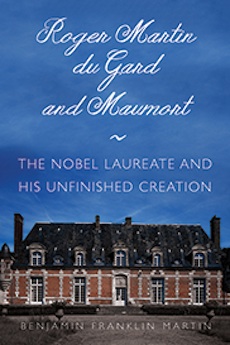By D.T. Siebert
Benjamin Franklin Martin’s literary biography of Roger Martin du Gard, who won the 1937 Nobel Prize for Literature, is an impressive achievement. (Note: Because the book’s subject and its author share the surname “Martin,” Roger Martin du Gard will be identified as “Roger,” as the book’s author himself does, and the author by “Martin.”)
The first half of the 20th century was fraught with important history—a time of two cataclysmic world wars, the rise of Marxist political influence and power, an ever-growing skepticism about religious belief, existentialist thought, new kinds of theory and practice in literature and the arts, and a sense of despair about the future of human civilization. Roger’s life and work embody this history. Fortunately for Martin, Roger was an indefatigable writer of personal journals and correspondence (which Martin himself has translated from the French). Martin shows how this personal writing takes on another life in Roger’s creative writing.
Besides Roger himself, major characters in this almost tragic drama—as “Hubris” or “Retribution” in the chapter titles would suggest—are Helene, Roger’s wife; Christiane, their only child; and Marcel de Coppet, Roger’s best friend and later, Christiane’s husband. All four are troubled individuals who torment each other with accusations and recriminations. A devout Roman Catholic, Helene blames the atheistic Roger for appropriating their daughter’s loyalty and making her a non-believer like himself. Helene remarks tellingly, “How strange that you are able to analyze your characters so brilliantly but you are never able to understand me.” And Roger feels stunned and betrayed when Christiane marries his friend Marcel, a man old enough to be her father. After Helene’s death and Christiane’s breakup with Marcel, Christiane constantly entreats Roger for substantial financial support, while at the same time blaming him for all her problems, and even occasionally threatening to kill herself. Before his death, Roger boxed up his voluminous personal writing and the manuscripts of his books, and deposited most of them in the Bibliotheque Nationale, fearing how his daughter might use or misuse them.
Fortunately Roger was a wealthy man—his money coming from inheritance, the Nobel Prize, and from substantial royalties for his published work. He acquired the family estate of Le Tertre, with its classically styled, 17th-century chateau (featured on the cover of Martin’s book), and spent large sums restoring it. Directing the renovation himself, he reveals something of his rather proud but insecure nature: “[The workmen] deride my ‘fine chateau,’ treating me like some idle bourgeois who knows nothing of construction or of the exhausting proletarian life. Yes, I live off my investments, and yes, I inherited money, but though I have no working-class consciousness, I am conscious of being a worker whom they have no right to ridicule.” When Roger claims to his friend Marcel that Le Tertre would be “an exceptional refuge against all that makes my life unpleasant,” Marcel replies, “You are deceiving yourself to justify a costly extravagance.”
Roger served in WWI behind the lines, but he was nonetheless aware of the war’s senseless carnage and destruction—vividly reflected in his novels. During WWII, he and Helene had to flee south to Vichy France, where even surviving involved great hardship, not to mention the ever-present fear of Gestapo arrest. Among many memorable details is that of Helene standing in line an hour just to get one artichoke.
Pervasive in French literature is the theme of the past, and its role in the present—as seen, for example, in Proust. This theme dominates Roger’s creative work as well as his own life. Indeed his uncompleted book Maumort is an account of an old, aristocratic army officer trying to remember, reconstruct, and come to terms with his past life. Roger was content that the book would never be completed—just as a cathedral, as he says, is always being built. He wrote to his wife: “No work has ever brought me such joy of creation. Absolutely none.”
Like the fascination with the past, the idea of “la belle mort” (the good or fitting death) is also prominent in French literature and thought. Montaigne wanted to judge a person’s life by the final touchstone of how that person died. This concern informs Martin’s account of Roger, who had witnessed the often gripping deaths of his family and friends—especially those of his mother and wife. One of Roger’s later friends was a priest, Auguste Valensin, S.J. Valensin attended Roger’s friend of many years, Andre Gide, during Gide’s final hours. In a letter, Valensin later conveyed this message: “Tell Roger that I am dying with as much dignity as Gide. And in joy.” Roger placed photographs of both Valensin and Gide at the foot of his bed, as he put it, “to help me die well.” And Roger’s motto for the fictional Maumort family is “De Male Mort Dieu Me Garde” (May God save me from a bad death).
Not very long before he died of a heart attack at Le Tertre, in the night of August 15-16, 1958, Roger had written his final words: “In the evening of a man’s life comes a moment of revelation when he realizes he is tired of living. . . . He is conscious of having had his time. Not that he wishes to die immediately, but he has had enough, he would be prefer to be finished with himself and return to nothingness. From that moment of having experienced this regret of being, the man is no longer the same. He begins the last step, the distinctive weariness of approaching death. . . . I have truly never had fear of oblivion, which I have always believed to be the inevitable end to life.”
D.T. Siebert (ΦBK, University of Oklahoma, 1962) is Distinguished Professor of English Literature Emeritus at the University of South Carolina, Columbia. Recent publications include Mortality’s Muse: The Fine Art of Dying (2013) and the chapter “Hume’s History of England” in the Oxford Handbook of Hume (2016).




